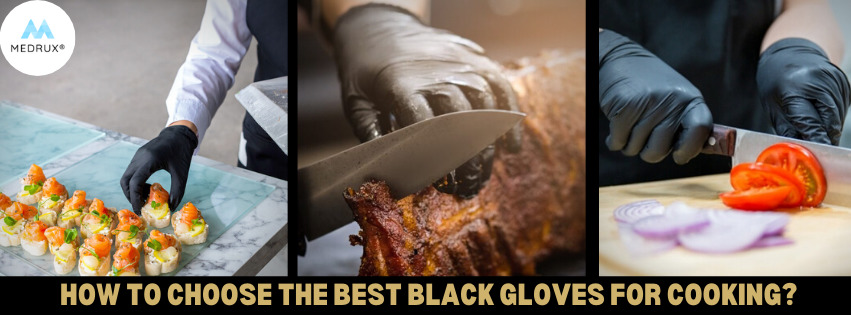Just imagine that you have your own food company or restaurant, and you provide a fantastic foodstuff with an excellent marketing job, but all this turned out to be a curse because of a glove!
A glove? Is that true? How?
“Yes,” it is true! Your glove quality, choice, and many other factors could ruin your business’s reputation and cause a massive loss!
Purchasing a bad quality glove for your staff or the wrong type of gloves is equivalent to handling the food with bare hands! So, all the germs on your writing will be directly found in the food you prepared or held, even if you are washing your hands regularly.
The use of disposable gloves for food prep and serving has become the norm in restaurant kitchens, dining rooms, cafés, and food service facilities worldwide.
Although health standards may demand protective hand, hair, and body covers, restaurant management increasingly recognizes the need to convey to consumers that they are serving clean, safe meals on well-regulated premises.
What are the consequences of not using gloves or using a low-quality glove?
The influence of food workers and other persons in food contamination has been highlighted as a significant contributing aspect to foodborne outbreaks.
Based on statistics, it has been found that “CDC estimates 48 million people get sick, 128,000 are hospitalized, and 3,000 die from foodborne diseases each year in the United States. CDC provides estimates for two major groups of foodborne illnesses – known pathogens and unspecified agents.”
So, how can I avoid this problem?
All you need is to choose the best glove in terms of quality and the type of tasks performed with this glove.
We will help you to avoid this problem now!
This article will mainly focus on all the information you need about the best cooking gloves, especially the black ones.
We will also tell you more about food-grade gloves, powdered and powder-free gloves, latex gloves alternatives, why you cannot use vinyl gloves for food-related duties, and more FDA food code and glove selection considerations.
All you need is to keep reading…
Let’s start; what are the food-grade gloves?
Different glove types are widely found in the glove market; the usage of each glove is other according to the duty.
The glove type matters the most regarding foodborne illness prevention due to gloves’ ability to reduce cross-contamination by providing the best barrier between the food and hands.
There are many food-grade gloves; however, you should look for the glove type that the FDA approves for the food-related duties.
So, what are the main features I should look for? Bottom line:
Always look for FDA-approved gloves before purchasing your gloves!
There are many options. Therefore, we will provide more information about each type with its pros and cons so that you can figure out which is the best for you…keep reading!
-
Powdered gloves Vs. Powder-free gloves
There are many benefits to both types of gloves; however, when it comes to food-related tasks, you have to choose what is safe for the food.
Powdered gloves are often used for easy donning and doffing, switching gloves from one task to another quicker and faster.
Furthermore, powder typically enhances the glove’s flexibility, providing high tear resistance.
Unfortunately, powdered gloves are not recommended for food-related duties since powder increases the likelihood of cross-contamination, which can lead to various food illness problems and many other complications.
On the other hand, powder-free gloves are commonly used for these tasks because the absence of powder remains is considered a potential threat of contamination.
Furthermore, the availability of novel manufacturing procedures, such as the chlorination phase of some gloves to replace the powder, has become a very successful strategy used to facilitate the donning and doffing of gloves while decreasing cross-contamination.
Bottom line:
It is recommended to use powder-free gloves rather than powdered gloves to minimize cross-contamination, resulting in poor food quality and a terrible reputation.
-
Colored gloves vs. white gloves… Does it matter?
All the glove color is just a stain used during any glove-type manufacturing process.
Years ago, all the available gloves were found in two primary colors which are white (neutral) and blue, so that glove users could be able to differentiate between the latex gloves that usually have white color and nitrile gloves that were found in blue color to avoid allergy reactions for those who suffer from it.
Later, glove market professionals introduced more colors to markets to provide a more effective management system for firms to remember which color should be used in a particular setting. The system has proved its efficacy among many firms.
What role do glove colors play?
1. Color coding technique
Recently, several firms have begun to use the color-coding technique to classify their job activities inside specific sectors within their workplace.
Some restaurants have been discovered to adopt the color-coding scheme, giving one glove color for a specific job, another for certain operations, and a third for hazard collection, for example.
Color coding is effective in reducing cross-contamination in many workplaces.
2. Glove doubling technique
Another advantage of employing colored gloves is that chefs frequently use the double glove strategy, just like doctors.
Their need to reduce contamination involves using two gloves, one white and the other purple, black, or any other hue, so they can identify a glove puncture as soon as it occurs.
So, why do most cooks and TV chefs specifically wear black?
You might notice many chefs and barbeque pit-masters usually wear black gloves.
Surprisingly, it has nothing to do with the function but instead with hiding the juicy sauce that creates a messy status.
Bottom line:
The glove color does not matter when it comes to the function.
What are the available options in the glove market? What to choose now?
So, we now notice that we should look for a powder-free glove, tear-resistant, black color, and sometimes a heat-resistant feature is preferable.
Let’s now explore most of the options found within the market, mention their pros and cons, and pick the best gloves for your task by the end of the article.
All you need to do is to guess an answer for each question… Let’s start now!
1. Do you think latex gloves are best for this job?
-
The good thing about the latex glove is…
Powder-free latex gloves are an excellent option for features like the comfortable fit, high sensitivity, high tear resistance, environmentally friendly nature, safe for extended use, and many other perfect characteristics.
-
The bad thing about latex gloves is…
However, due to the ability of latex gloves to cause allergy in a large population, several governments have outlawed their usage in addition to its high cost compared to other types.
All these factors have lowered its standing among many other types of gloves.
Bottom line:
Generally, latex gloves are commonly used in food preparation tasks. However, it is not recommended for people who suffer from sensitive skin due to allergies.
2. Do you think vinyl gloves are best for this job?
-
The good thing about the vinyl glove is…
Based on many reviews, it has been found that vinyl gloves are commonly used in food-related tasks due to their ability to provide comfort while handling all food staff, and it does not contain latex; therefore, it is safe for people who are sensitive to latex.
-
The bad thing about the vinyl glove is…
Unfortunately, based on research, it has been found that vinyl gloves are composed of inexpensive phthalates DINP (Diisononyl phthalate) and DEHP (Bis(2-Ethylhexyl) phthalate), and BPA (Bisphenol A).
Worth to mention that these materials are known to cause cancer and heart diseases.
Moreover, the adverse health consequences of BPA and phthalates in food and work environments in the United States are predicted to cost $175 billion in healthcare expenses.
Bottom line:
Vinyl is not recommended for food task jobs due to its adverse effect on human health.
Vinyl & Latex gloves impact human health in numbers!
Based on statistics, it has been found that vinyl and latex gloves allowed passage of 1.4 and 1.5% of poliovirus, and 63% of vinyl gloves and 7% of latex gloves leaked a bacteriophage (27 nm in diameter) during experimental clinical procedures.
Although viral penetration is less of a concern in the food industry than in health care settings, gloves should be durable enough to withstand the rigors of specific food handling operations.
3. Do you think nitrile gloves are best for this job?
Looking for a short answer…Nitrile gloves are the best for cooking duties and are approved by FDA!
Why?
This is due to many features that will make you…
-
Don’t have to think about the contamination problem
With nitrile gloves, you won’t worry about the contamination problem that might ruin your whole business due to the high puncture resistance that nitrile gloves provide you.
The gloves’ exceptional tear resistance makes them an excellent choice for protecting against sharp knives and equipment when handling meat and bones. So, excellent work!
-
If your meal necessitates heat, you won’t have to worry about melting.
The nitrile substance used to make black nitrile gloves is ideal for use around heat conditions like barbeque. But it is essential to note that these gloves are not completely heat resistant.
Black nitrile, however, withstands mild heat better than sensitive gloves, such as poly, which may melt at a specific temperature.
Moreover, it also provides resistance to high temperatures ranging from 40 to 108 °C (40 to 226 °F), making it perfect for jobs that require touching hot or cold surfaces.
That’s why, in many industries, nitrile gloves are by far the superior option since they protect against extreme heat or cold without melting or becoming brittle.
They are great for handling, chopping, serving hot meals, and preparing meat before it is cooked.
-
You don’t have to suffer from allergies!
The entire procedure is different since a chlorinated finish is added during manufacture, enabling easy donning and doffing. As a result, nitrile gloves offer an allergy-free experience and low friction performance, resulting in higher quality.
-
You can find it in black color!
Nitrile gloves can be found in a variety of hues.
So, if you are working as a chef and want to hide your messy hand due to stains in front of your customers, you can find nitrile gloves in a black color that will give you a proper look.
Bottom line:
Black nitrile gloves can provide you with all the features you want to perform your cooking tasks perfectly.
Final thoughts…
It is essential to shedding light on the importance of wearing gloves while preparing food, and you should know that wearing a glove does not replace your hand washing procedure.
Now, we have reached the end of our article. I hope you enjoyed reading and have the information needed to purchase your perfect glove for cooking.
You can also check our article about dreadful things to avoid while choosing suitable gloves for food service. “Click here“!
Finally, the choice is yours!
Hajar Nagdy is a microbiologist and a lecturer. Nagdy holds a Bachelor’s degree in the fields of microbiology and environmental sciences, and she is now a M.Sc. candidate in microbiology. In her free time, she can be found listening to classical music, reading interesting scientific articles, running a charity, or traveling across Europe.








